Air Pollutants Emission during Co-Combustion of Animal Manure and Wood Pellets in 15 kW Boiler
Abstract
:1. Introduction
2. Materials and Methods
2.1. Measuring Stand
2.2. Fuel
2.3. Plan of Experiment
- -
- 100% wood pellets;
- -
- 75% wood pellets and 25% manure pellets;
- -
- 50% wood pellets and 50% manure pellets;
- -
- 25% wood pellets and 75% manure pellets;
- -
- 100% manure pellets.
3. Results and Discussion
3.1. Parameters and Chemical Composition of the Tested Fuels
- -
- Low heating value: 11.95–17.61 MJ·kg−1;
- -
- High heating value: 11.08–16.34 MJ·kg−1;
- -
- Ash content: 11.62–37.85%;
- -
- Carbon content: 25.65–44.24%;
- -
- Nitrogen content: 0.90–2.64%;
- -
- Hydrogen content: 3.43–5.69%;
- -
- Sulfur content: 0.18–0.80%;
- -
- Chlorine content: 0.10–1.04%.
3.2. 100% Wood Pellets
3.3. Mixture of 75% Wood Pellets and 25% Manure Pellets
3.4. Mixture of 50% Wood Pellets and 50% Manure Pellets
3.5. Mixture of 25% Wood Pellets and 75% Manure Pellets
3.6. 100% Manure Pellets
3.7. Summary of Tests
4. Conclusions
- -
- Manure pellets characterized by higher moisture—9.2%, lower high heating value—17.25 MJ·kg−1, lower low heating value—16.45 MJ·kg−1 and higher ash content—11.23%, than wood pellets (6.4%, 19.51 MJ·kg−1, 19.07 MJ·kg−1 and 0.39, respectively).
- -
- The average boiler power during the combustion of 100% wood pellets was 13.6 kW (air–fuel ratio 1.48), and it was close to the nominal maximum power, and the average concentrations of CO, NOx and dust were lower than the values required by the Ecodesign Directive, and they were 198 ± 27 mg·m−3, 198 ± 8 mg·m−3 and 8.7 ± 0.5 mg·m−3, respectively. The NO concentration was on average 129 ± 5 mg·m−3.
- -
- Increasing the share of manure pellets in the burning mixture worsened the stability of the combustion process, and the occurrence of incomplete combustion was observed, which resulted in an increased concentration of CO and dust. Additionally, NO and NOx concentrations also increased.
- -
- The average boiler power during the combustion of 100% manure pellets was 7.8 kW (air–fuel ratio 2.2), and the average concentrations of CO, NO, NOx and dust were 1548 ± 555 mg·m−3, 355 ± 53 mg·m−3, 554 ± 88 mg·m−3 and 482 ± 63 mg·m−3, respectively.
Author Contributions
Funding
Data Availability Statement
Conflicts of Interest
References
- Papież, M.; Śmiech, S.; Frodyma, K. Determinants of renewable energy development in the EU countries. A 20-year perspective. Renew. Sustain. Energy Rev. 2018, 91, 918–934. [Google Scholar] [CrossRef]
- Manowska, A. Renewable energy sources in the Polish energy structure. Zesz. Nauk. Inst. Gospod. Surowcami Miner. Pol. Akad. Nauk 2019, 109, 111–122. [Google Scholar]
- Bórawski, P.; Bełdycka-Bórawska, A.; Szymańska, E.J.; Jankowski, K.J.; Dubis, B.; Dunn, J.W. Development of renewable energy sources market and biofuels in The European Union. J. Clean. Prod. 2019, 228, 467–484. [Google Scholar] [CrossRef]
- Rajamani, L.; Bodansky, D. The Paris rulebook: Balancing international prescriptiveness with national discretion. Int. Comp. Law Q. 2019, 68, 1023–1040. [Google Scholar] [CrossRef]
- Mohammed, K.S.; Usman, M.; Ahmad, P.; Bulgamaa, U. Do all renewable energy stocks react to the war in Ukraine? Russo-Ukrainian conflict perspective. Environ. Sci. Pollut. Res. 2022, 30, 36782–36793. [Google Scholar] [CrossRef] [PubMed]
- Ugwua, S.N.; Enweremadu, C.C. Effects of pre-treatments and co-digestion on biogas production from Okra Waste. J. Renew. Sustain. Energy 2019, 11, 013101. [Google Scholar] [CrossRef]
- Obidziński, S.; Puchlik, M.; Dołżyńska, M. Pelletization of Post-Harvest Tobacco Waste and Investigation of Flue Gas Emissions from Pellet Combustion. Energies 2020, 13, 6002. [Google Scholar] [CrossRef]
- Kowalczyk-Juśko, A.; Pochwatka, P.; Zaborowicz, M.; Czekała, W.; Mazurkiewicz, J.; Janczak, D.M.; Marczuk, A.; Dach, J. Energy value estimation of silages for substrate in biogas plants using an artificial neural network. Energy 2020, 202, 117729. [Google Scholar] [CrossRef]
- Czyżyk, F.; Strzelczyk, M. Rational utilization of production residues generated in agri-food. Arch. Gospod. Odpad. I Ochr. Sr. 2015, 17, 99–106. [Google Scholar]
- Dołżyska, M.; Obidziński, S.; Piekut, J.; Yildiz, G. The utilization of plum stones for pellet production and investigation of post-combustion flue gas emissions. Energies 2020, 13, 5107. [Google Scholar] [CrossRef]
- Ayilara, M.S.; Olanrewaju, O.S.; Babalola, O.O.; Odeyemi, O. Waste Management through Composting: Challenges and Potentials. Sustainability 2020, 12, 4456. [Google Scholar] [CrossRef]
- Koszel, M.; Lorencowicz, E. Agricultural Use of Biogas Digestate as a Replacement Fertilizers. Agric. Agric. Sci. Procedia 2015, 7, 119–124. [Google Scholar] [CrossRef]
- Hung, C.; Tsai, W.; Chen, J.; Lin, Y.; Chang, Y. Characterization of biochar prepared from biogas digestate. Waste Manag. 2017, 66, 53–60. [Google Scholar] [CrossRef] [PubMed]
- Minutillo, M.; Perna, A.; Sorce, A. Combined hydrogen, heat and electricity generation via biogas reforming: Energy and economic assessments. Int. J. Hydrogen Energy 2019, 44, 23880–23898. [Google Scholar] [CrossRef]
- Digman, B.; Joo, H.S.; Kim, D.-S. Recent Progress in Gasification/Pyrolysis Technologies for Biomass Conversion to Energy. Environ. Prog. Sustain. 2009, 28, 47–51. [Google Scholar] [CrossRef]
- Mostafa, M.E.; Hu, S.; Wang, Y.; Su, S.; Hu, X.; Elsayed, S.A.; Xiang, J. The significance of pelletization operating conditions: An analysis of physical and mechanical characteristics as well as energy consumption of biomass pellets. Renew. Sustain. Energy Rev. 2019, 105, 332–348. [Google Scholar] [CrossRef]
- Czekała, W.; Bartnikowska, S.; Dach, J.; Janczak, D.; Smurzyńska, A.; Kozłowski, K.; Bugała, A.; Lewicki, A.; Cieślik, M.; Typańnska, D.; et al. The energy value and economic efficiency of solid biofuels produced from digestate and sawdust. Energy 2018, 159, 1118–1122. [Google Scholar] [CrossRef]
- Križan, P.; Matú, M.; Šooš, L.; Beniak, J. Behavior of Beech Sawdust during Densification into a Solid Biofuel. Energies 2015, 8, 6382–6398. [Google Scholar] [CrossRef]
- Juszczak, M. Correlation between air flow rate and pollutant concentrations during two-stage oak log combustion in a 25 KW residential boiler. Chem. Process Eng.-Inz. 2016, 37, 419–428. [Google Scholar] [CrossRef]
- Katsaros, G.; Sommersacher, P.; Retschitzegger, S.; Kienzl, N.; Tassou, S.A.; Pandey, D.S. Combustion of poultry litter and mixture of poultry litter with woodchips in a fixed bed lab-scale batch reactor. Fuel 2021, 286, 119310. [Google Scholar] [CrossRef]
- Dhungana, B.; Lohani, S.P.; Marsolek, M. Anaerobic Co-Digestion of Food Waste with Livestock Manure at Ambient Temperature: A Biogas Based Circular Economy and Sustainable Development Goals. Sustainability 2022, 14, 3307. [Google Scholar] [CrossRef]
- Maj, I. Significance and Challenges of Poultry Litter and Cattle Manure as Sustainable Fuels: A Review. Energies 2022, 15, 8981. [Google Scholar] [CrossRef]
- Sweeten, J.M.; Korenberg, J.; LePori, W.A.; Annamalai, K.; Parnell, C.B. Combustion of cattle feedlot manure for energy production. Energy Agric. 1986, 5, 55–72. [Google Scholar] [CrossRef]
- Annamalai, K.; Ibrahim, M.Y.; Sweeten, J.M. Experimental studies on combustion of cattle manure in a fluidized bed combustor. J. Energy Resour. Technol. 1987, 109, 49–57. [Google Scholar] [CrossRef]
- Annamalai, K.; Madan, A.M.; Sweeten, J.M.; Chi, D. Fluidized bed combustion of manure: Experiment and theory. In Agricultural Waste Utilization and Management, Proceedings of the 5th International Symposium on Agricultural Wastes, Chicago, IL, USA, 16–17 December 1985; American Society of Agricultural Engineers: Chicago, IL, USA, 1985; pp. 37–45. [Google Scholar]
- Have, H.; Fritze, M. Heat Energy from Animal Waste by Combined Drying, Combustion and Heat Recovery. In Energy from Biomass. Solar Energy R & D in the European Community; Chartier, P., Palz, W., Eds.; Springer: Dordrecht, The Netherlands, 1981; Volume 1. [Google Scholar] [CrossRef]
- Madan, A.M. Experimental Study of Fluidized Bed Combustion of Feedlot Manure. Ph.D. Thesis, Texas A&M University, College Station, TX, USA, 1984. [Google Scholar]
- Augustin, B.; Bockenhauer, M. Electric Power Generation from Direct Combustion of Feedlot Waste. Geogr. Bull. 1987, 29, 15–20. [Google Scholar]
- Schuster, R.; Stroemberg, B. Combustion of Manure Foerbraenning av Goedsel. En Orienterande Litteraturstudie Med Kommentarer; Stiftelsen foer Vaermeteknisk Forskning: Stockholm, Sweden, 1997. [Google Scholar]
- Yurdakul, S. Determination of Co-Combustion Properties and Thermal Kinetics of Poultry Litter/Coal Blends Using Thermogravimetry. Renew. Energy 2016, 89, 215–223. [Google Scholar] [CrossRef]
- Jiang, C.; Lin, Q.; Wang, C.; Jiang, X.; Bi, H.; Bao, L. Experimental Study of the Ignition and Combustion Characteristics of Cattle Manure under Different Environmental Conditions. Energy 2020, 197, 117143. [Google Scholar] [CrossRef]
- Thengane, S.K.; Gupta, A.; Mahajani, S.M. Co-Gasification of High Ash Biomass and High Ash Coal in Downdraft Gasifier. Bioresour. Technol. 2019, 273, 159–168. [Google Scholar] [CrossRef] [PubMed]
- Hupa, M. Ash-Related Issues in Fluidized-Bed Combustion of Biomasses: Recent Research Highlights. Energy Fuels 2012, 26, 4–14. [Google Scholar] [CrossRef]
- Zając, G.; Szyszlak-Bargłowicz, J.; Gołębiowski, W.; Szczepanik, M. Chemical Characteristics of Biomass Ashes. Energies 2018, 11, 2885. [Google Scholar] [CrossRef]
- Ecodesign Directive 2015. Commission Regulation (EU) 2015/1189 of 28 April 2015 Implementing Directive 2009/125/EC of the European Parliament and of the Council with Regard to Ecodesign Requirements for Solid Fuel Boilers. Available online: https://www.legislation.gov.uk/eur/2015/1189 (accessed on 4 August 2023).
- Obidziński, S.; Joka Yildiz, M.; Dąbrowski, S.; Jasiński, J.; Czekała, W. Application of Post-Flotation Dairy Sludge in the Production of Wood Pellets: Pelletization and Combustion Analysis. Energies 2022, 15, 9427. [Google Scholar] [CrossRef]
- Azargohar, R.; Nanda, S.; Dalai, A.K. Densification of Agricultural Wastes and Forest Residues: A Review on Influential Parameters and Treatments. In Recent Advancements in Biofuels and Bioenergy Utilization; Sarangi, P., Nanda, S., Mohanty, P., Eds.; Springer: Singapore, 2018; pp. 27–51. [Google Scholar]
- García, R.; Gil, M.V.; Rubiera, F.; Pevida, C. Pelletization of wood and alternative residual biomass blends for producing industrial quality pellets. Fuel 2019, 251, 739–753. [Google Scholar] [CrossRef]
- Guo, F.; Zhong, Z. Optimization of the co-combustion of coal and composite biomass pellets. J. Clean. Prod. 2018, 185, 399–407. [Google Scholar] [CrossRef]
- Tańczuk, M.; Junga, R.; Werle, S.; Chabiński, M. Experimental analysis of the fixed bed gasification process of the mixtures of the chicken manure with biomass. Renew. Energy 2019, 136, 1055–1063. [Google Scholar] [CrossRef]
- PN-EN 303-5:2021-09; Heating Boilers—Part 5: Heating Boilers for Solid Fuels, Manually and Automatically Stoked, Nominal Heat Output of up to 500 kW—Terminology, Requirements, Testing and Marking. Polish Committee for Standardization: Warsaw, Poland, 2021.
- PN-EN12880:2004; Characterization of Sludges—Determination of Dry Residue and Water Content. Polish Committee for Standardization: Warsaw, Poland, 2004.
- PN-EN 12879:2004; Characteristics of Sewage Sludge—Determination of Losses on Ignition of Sludge Dry Mass. Polish Committee for Standardization: Warsaw, Poland, 2004.
- PN-ISO 1928:2020-05; Solid Fuels—Determination of Heat of Combustion by Bomb Calorimetric Method and Calorific Value Calculation. Polish Committee for Standardization: Warsaw, Poland, 2020.
- PN-EN 15104:2011; Solid Biofuels—Determination of Total Carbon, Hydrogen and Nitrogen Content—Instrumental Methods. Polish Committee for Standardization: Warsaw, Poland, 2011.
- PN-EN 15289:2011; Solid Biofuels—Determination of Total Sulphur and Chlorine. Polish Committee for Standardization: Warsaw, Poland, 2011.
- PN-EN ISO 17225-2:2021; Solid biofuels—Fuel Specifications and Classes—Part 2: Graded Wood Pellets. Polish Committee for Standardization: Warsaw, Poland, 2021.
- Chandrasekaran, S.R.; Hopke, P.K.; Rector, L.; Allen, G.; Lin, L. Chemical Composition of Wood Chips and Wood Pellets. Energy Fuels 2012, 26, 4932–4937. [Google Scholar] [CrossRef]
- Venturini, E.; Vassura, I.; Agostini, F.; Pizzi, A.; Toscano, G.; Passarini, F. Effect of fuel quality classes on the emissions of a residential wood pellet stove. Fuel 2018, 211, 269–277. [Google Scholar] [CrossRef]
- Telmo, C.; Lousada, J. Heating values of wood pellets from different species. Biomass Bioenergy 2011, 35, 2634–2639. [Google Scholar] [CrossRef]
- Stolarski, M.J.; Stachowicz, P.; Dudziec, P. Wood pellet quality depending on dendromass species. Renew. Energy 2022, 199, 498–508. [Google Scholar] [CrossRef]
- Szymajda, A.; Łaska, G.; Joka, M. Assessment of Cow Dung Pellets as a Renewable Solid Fuel in Direct Combustion Technologies. Energies 2021, 14, 1192. [Google Scholar] [CrossRef]
- Vankát, A.; Krepl, V.; Kára, J. Animal dung as a source of energy in remote areas of Indian Himalayas. Agric. Trop. Subtrop. 2010, 43, 140–142. [Google Scholar]
- Wang, J.; Ma, M.; Bai, Y.; Su, W.; Song, X.; Yu, G. Effect of CaO additive on co-pyrolysis behaviour of bituminous coal and cow dung. Fuel 2020, 265, 116911. [Google Scholar] [CrossRef]
- Cwalina, P.; Obidziński, S.; Kowczyk-Sadowy, M.; Krasowska, M.; Siegień, G. Management of Waste from the Dairy Industry for Energy Purposes. Environ. Sci. Proc. 2022, 18, 4. [Google Scholar] [CrossRef]
- Pełka, G.; Jach-Nocoń, M.; Paprocki, M.; Jachimowski, A.; Luboń, W.; Nocoń, A.; Wygoda, M.; Wyczesany, P.; Pachytel, P.; Mirowski, T. Comparison of Emissions and Efficiency of Two Types of Burners When Burning Wood Pellets from Different Suppliers. Energies 2023, 16, 1695. [Google Scholar] [CrossRef]
- Archan, G.; Anca-Couce, A.; Buchmayr, M.; Hochenauer, C.; Gruber, J.; Scharler, R. Experimental evaluation of primary measures for NOX and dust emission reduction in a novel 200 kW multi-fuel biomass boiler. Renew. Energy 2012, 170, 1186–1196. [Google Scholar] [CrossRef]
- Verma, V.K.; Bram, S.; Delattin, F.; De Ruyck, J. Real life performance of domestic pellet boiler technologies as a function of operational loads: A case study of Belgium. Appl. Energy 2013, 101, 357–362. [Google Scholar] [CrossRef]
- Ghafghazi, S.; Sowlati, T.; Sokhansanj, S.; Bi, X.; Melin, S. Particulate matter emissions from combustion of wood in district heating applications. Renew. Sustain. Energy Rev. 2011, 15, 3019–3028. [Google Scholar] [CrossRef]
- Johansson, L.S.; Tullin, C.; Leckner, B.; Sjövall, P. Particle emissions from biomass combustion in small combustors. Biomass Bioenergy 2003, 25, 435–446. [Google Scholar] [CrossRef]
- Musialik-Piotrowska, A.; Kordylewski, W.; Ciołek, J.; Mościcki, K. Characteristics of air pollutants emitted from biomass combustion in small retort boiler. Environ. Prot. Eng. 2010, 36, 123–131. [Google Scholar]
- Mustafa, B.G.; Kiah, M.H.M.; Irshad, A.; Andrews, G.E.; Phylaktou, H.N.; Li, H.; Gibbs, B.M. Rich biomass combustion: Gaseous and particle number emissions. Fuel 2019, 248, 221–231. [Google Scholar] [CrossRef]
- Juszczak, M. Concentrations of carbon monoxide and nitrogen oxides from a 15 kW heating boiler supplied periodically with a mixture of sunflower husk and wood pellets. Environ. Prot. Eng. 2014, 40, 65–74. [Google Scholar] [CrossRef]
- Pałaszyńska, K.; Juszczak, M.; Ostrowski, R. Carbon monoxide and nitric oxide concentrations in flue gas during combustion of agricultural biomass in the residental boiler. Drew. Pr. Nauk. Doniesienia Komun. 2021, 64, 125–144. [Google Scholar] [CrossRef]
- Wasilewski, J.; Zając, G.; Szyszlak-Bargłowicz, J.; Kuranc, A. Evaluation of Greenhouse Gas Emission Levels during the Combustion of Selected Types of Agricultural Biomass. Energies 2022, 15, 7335. [Google Scholar] [CrossRef]
- Zhai, M.; Li, X.; Yang, D.; Ma, Z.; Dong, P. Ash Fusion Characteristics of Biomass Pellets during Combustion. J. Clean. Prod. 2022, 336, 130361. [Google Scholar] [CrossRef]
- Gupta, K.K.; Aneja, K.R.; Rana, D. Current Status of Cow Dung as a Bioresource for Sustainable Development. Bioresour. Bioprocess. 2016, 3, 28. [Google Scholar] [CrossRef]
- Lundgren, J.; Pettersson, E. Combustion of horse manure for heat production. Bioresour. Technol. 2009, 100, 3121–3126. [Google Scholar] [CrossRef] [PubMed]
- Vamvuka, D.; Alloimonos, N. Combustion behavior of olive pruning/animal manure blends in a fluidized bed combustor. Heliyon 2017, 3, e00385. [Google Scholar] [CrossRef]
- Puustinen, H.; Kajolinna, T.; Pellikka, T.; Kouki, J.; Vuorio, K. Characterization of Airborne Emissions from Combustion of Horse Manure; Research report VTT-R-01295-09; VTT: Espoo, Finland, 2009; 18p. (In Finnish) [Google Scholar]
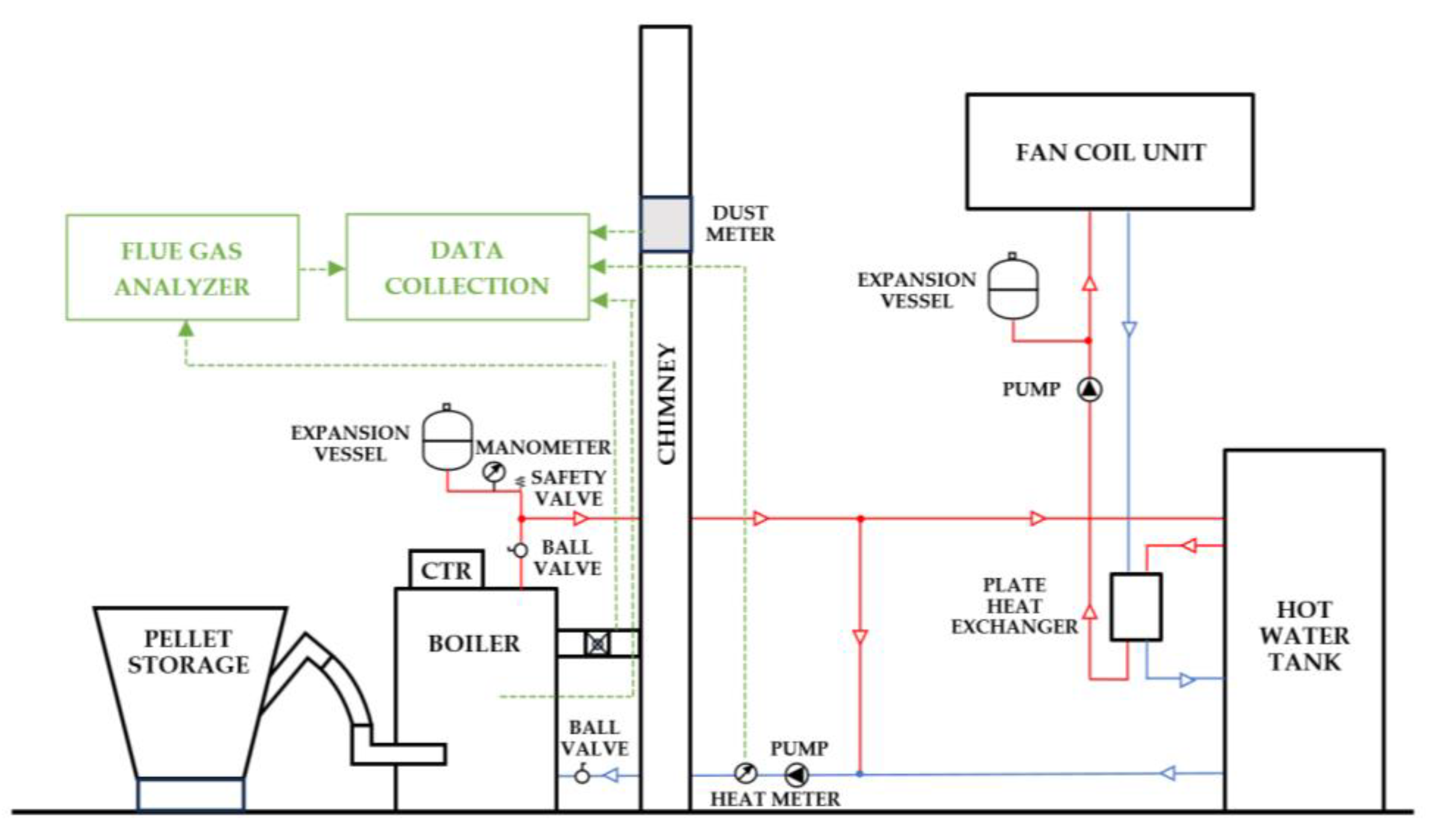



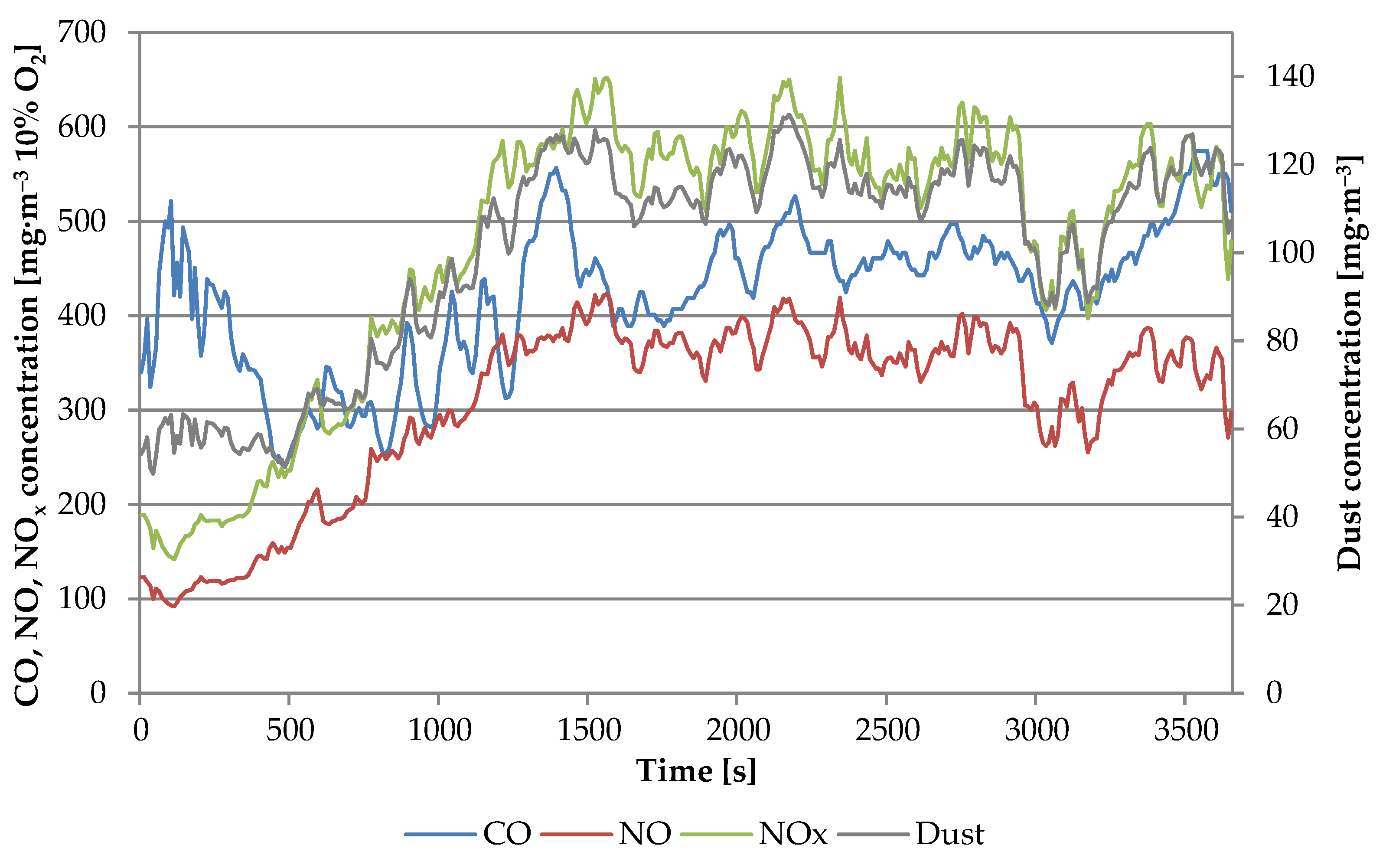
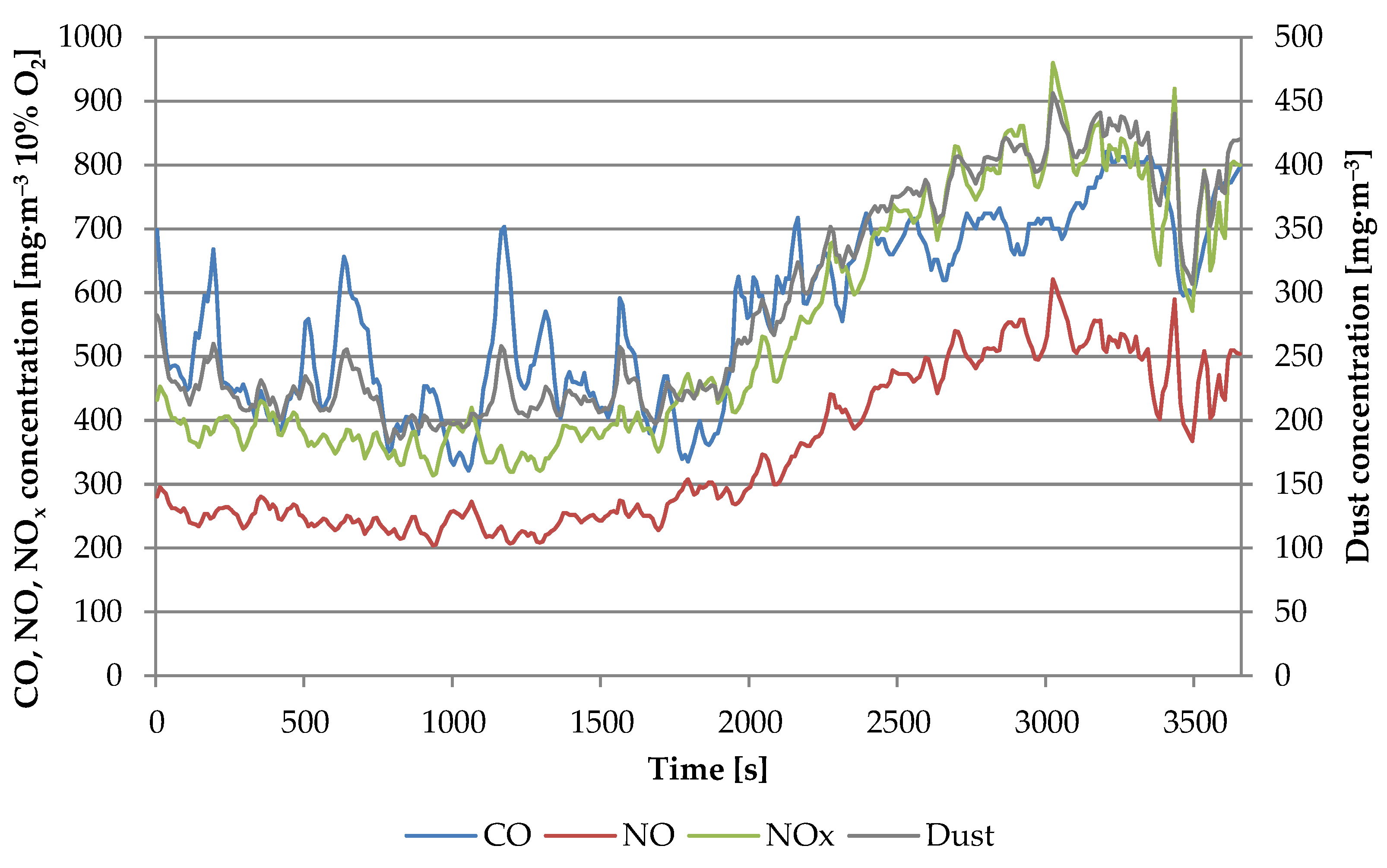
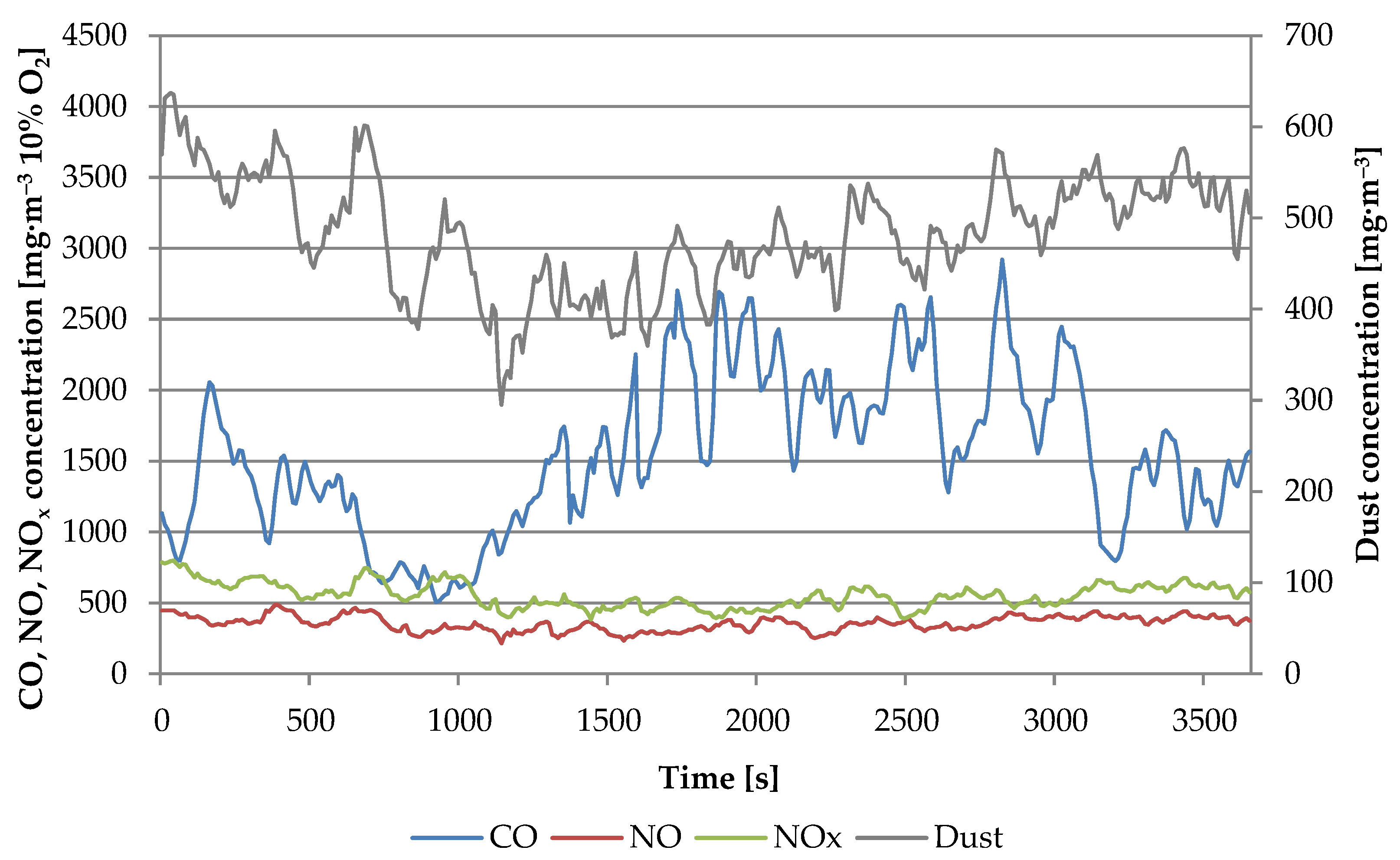

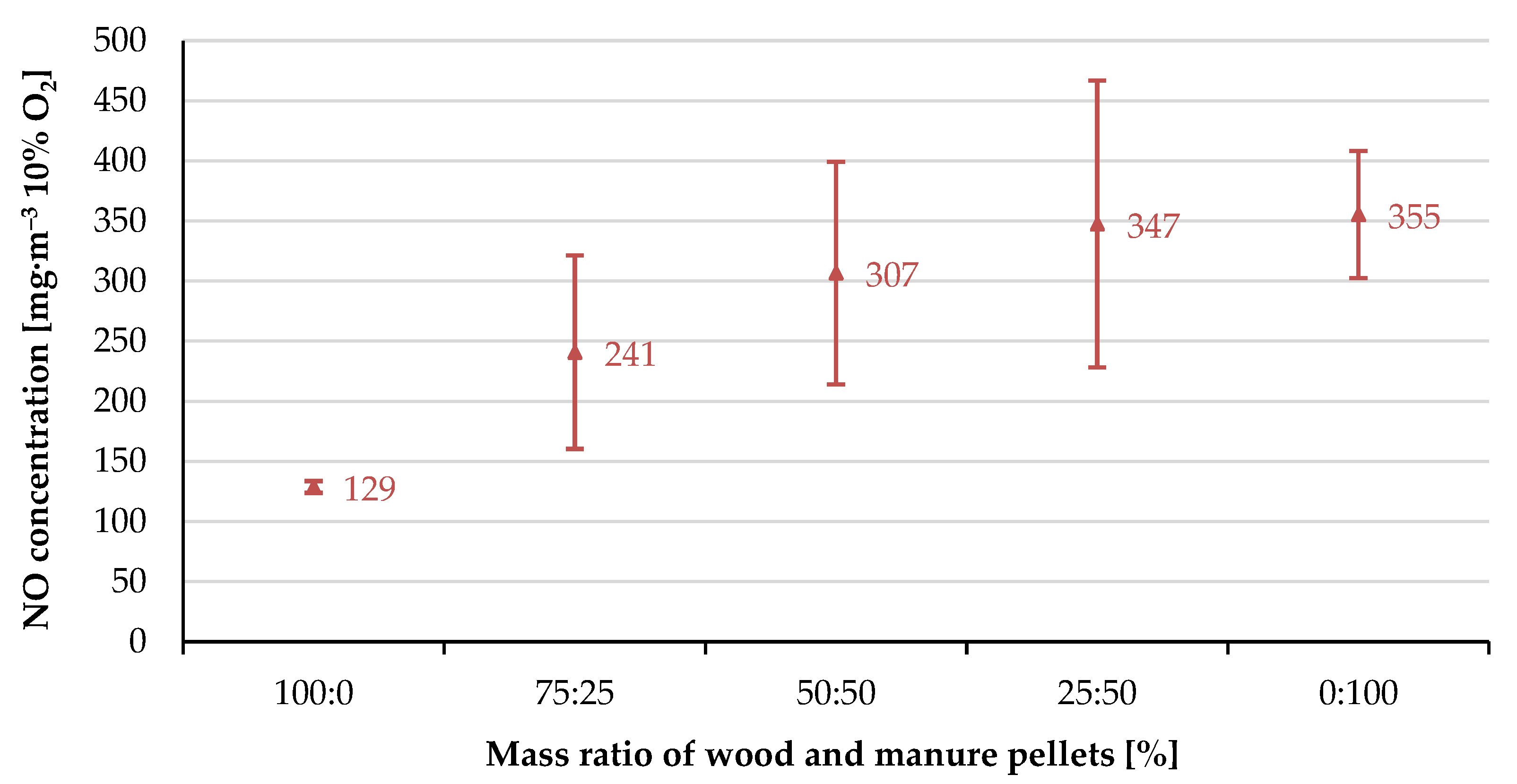
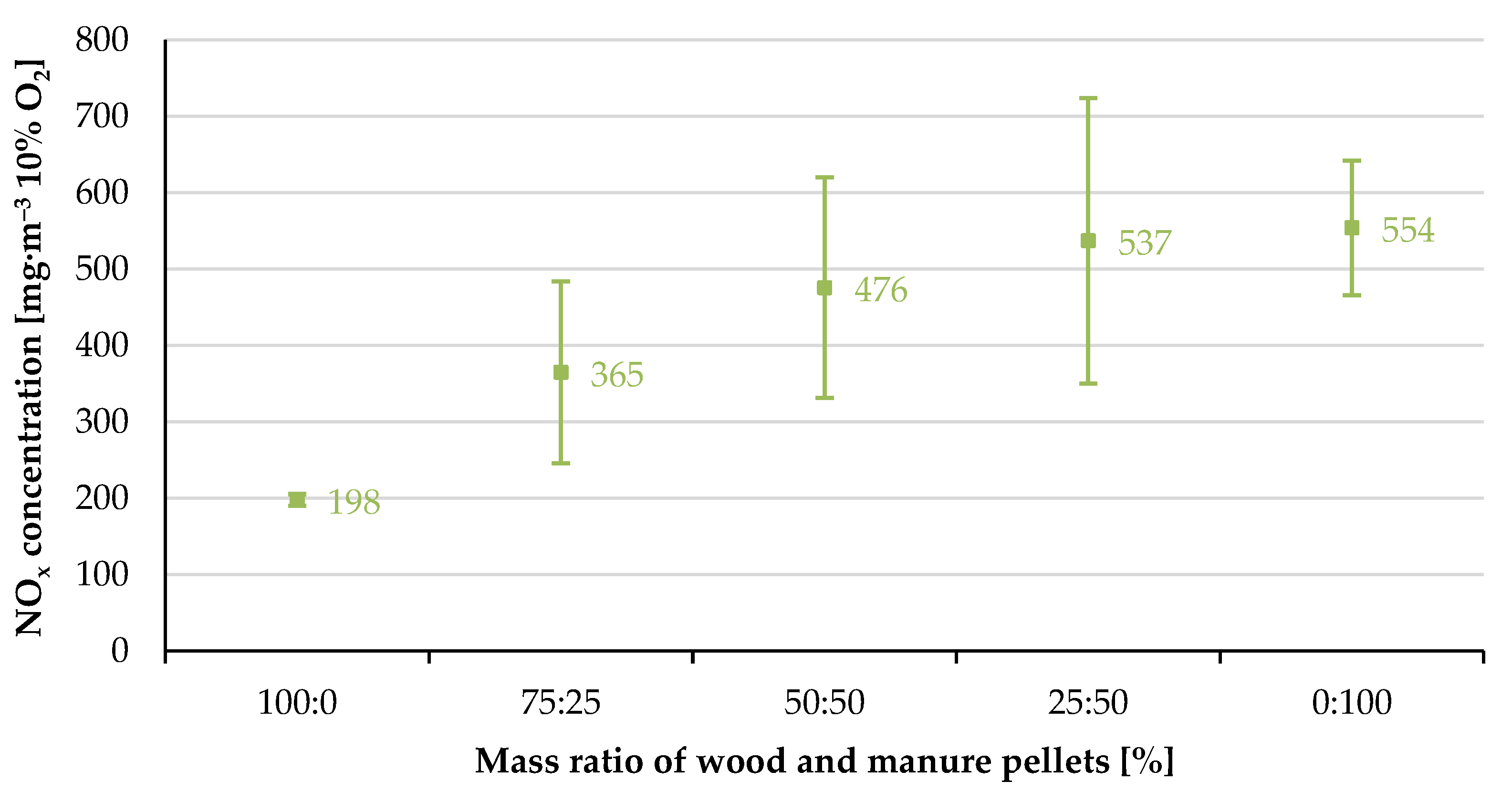
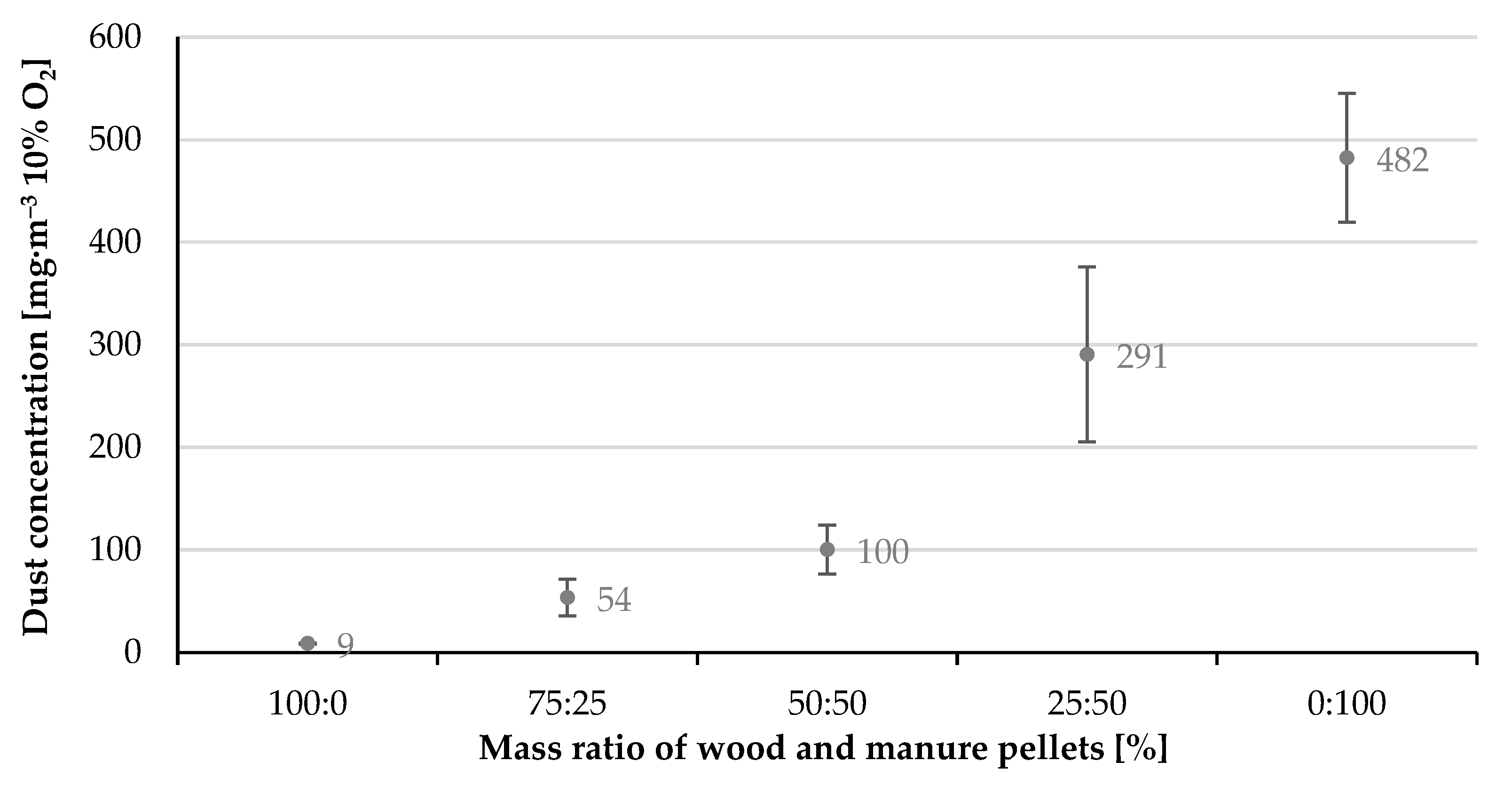
| Measured Values | Measuring Range | Measurement Accuracy |
|---|---|---|
| O2 | 0–21 Vol% | ±0.2 Vol% abs. |
| CO | 0–4% | ±0.02% or 5% of reading |
| NO | 0–1000 ppm | ±5 ppm or ±5% of reading |
| NOx | 0–200 ppm | ±10 ppm or ±5% of reading |
| Parameter | Wood Pellet | Manure Pellet |
|---|---|---|
| Maximum humidity (%) | 6.4 | 9.2 |
| High heat value (MJ·kg−1) | 19.51 | 17.25 |
| Low heat value (MJ·kg−1) | 19.07 | 16.45 |
| Length (mm) | 5–35 | 5–40 |
| Diameter (mm) | 8 | 8 |
| Density (kg·m−3) | 1110 | 1215 |
| Ash content (%) | 0.39 | 11.23 |
| Carbon content (%) | 50.1 | 36.2 |
| Nitrogen content (%) | 0.22 | 2.31 |
| Hydrogen content (%) | 6.12 | 4.51 |
| Sulfur content (%) | 0.09 | 0.21 |
| Chlorine content (%) | 0.54 | 0.92 |
| Parameter | Mass Ratio of Wood and Manure Pellets (%) | ||||
|---|---|---|---|---|---|
| 100:0 | 75:25 | 50:50 | 25:75 | 0:100 | |
| Power (kW) | 13.6 | 12.4 | 12.2 | 10.8 | 7.8 |
| Boiler efficiency (%) | 94.5 | 94.3 | 93.5 | 93.1 | 92.4 |
| Oxygen content (%) | 6.8 | 7.1 | 7.7 | 8.8 | 11.6 |
| Air–fuel ratio (-) | 1.48 | 1.52 | 1.58 | 1.66 | 2.18 |
| Chamber temperature (°C) | 612 | 616 | 575 | 567 | 368 |
| Flue gas temperature (°C) | 145 | 138 | 132 | 122 | 97 |
Disclaimer/Publisher’s Note: The statements, opinions and data contained in all publications are solely those of the individual author(s) and contributor(s) and not of MDPI and/or the editor(s). MDPI and/or the editor(s) disclaim responsibility for any injury to people or property resulting from any ideas, methods, instructions or products referred to in the content. |
© 2023 by the authors. Licensee MDPI, Basel, Switzerland. This article is an open access article distributed under the terms and conditions of the Creative Commons Attribution (CC BY) license (https://creativecommons.org/licenses/by/4.0/).
Share and Cite
Rzeźnik, W.; Rzeźnik, I.; Mielcarek-Bocheńska, P.; Urbański, M. Air Pollutants Emission during Co-Combustion of Animal Manure and Wood Pellets in 15 kW Boiler. Energies 2023, 16, 6691. https://doi.org/10.3390/en16186691
Rzeźnik W, Rzeźnik I, Mielcarek-Bocheńska P, Urbański M. Air Pollutants Emission during Co-Combustion of Animal Manure and Wood Pellets in 15 kW Boiler. Energies. 2023; 16(18):6691. https://doi.org/10.3390/en16186691
Chicago/Turabian StyleRzeźnik, Wojciech, Ilona Rzeźnik, Paulina Mielcarek-Bocheńska, and Mateusz Urbański. 2023. "Air Pollutants Emission during Co-Combustion of Animal Manure and Wood Pellets in 15 kW Boiler" Energies 16, no. 18: 6691. https://doi.org/10.3390/en16186691
APA StyleRzeźnik, W., Rzeźnik, I., Mielcarek-Bocheńska, P., & Urbański, M. (2023). Air Pollutants Emission during Co-Combustion of Animal Manure and Wood Pellets in 15 kW Boiler. Energies, 16(18), 6691. https://doi.org/10.3390/en16186691






